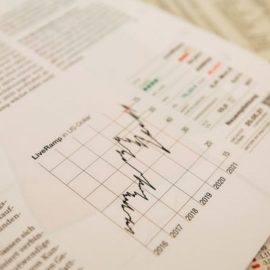

This article is an excerpt from the Shortform book guide to "Money: Master the Game" by Tony Robbins. Shortform has the world's best summaries and analyses of books you should be reading.
Like this article? Sign up for a free trial here .
How does asset diversification work? Why is it important when you’re investing in stocks?
Asset diversification means spreading your assets around in a portfolio to reduce losses. Tony Robbins describes this practice in his book Money: Master the Game, in which he gives tips on how to properly diversify your assets so you don’t risk all of your stocks plummeting.
For more information on the diversification of assets, keep reading.
What Is Asset Diversification?
The overriding goal of asset diversification is to build a portfolio that can withstand both good and bad market conditions: If one asset plummets, the rest buffer the loss. The market always “reverts to the mean”—booms and busts are temporary, while average growth is the general rule. If you allocate intelligently, you can mitigate your losses in bad times and ensure substantial gains in good times. To do this, use the following three tactics:
Tactic #1: Diversify between asset classes. In other words, buy some bonds, some stocks, and some commodities.
Tactic #2: Diversify between markets. In addition to holding both stocks and bonds, aim also to hold different types of stocks and bonds. Since the markets don’t all move together—for example, real estate is only loosely related to oil prices—you can mitigate market drops by holding assets in a wide range of markets.
Tactic #3: Diversify over time. You can also diversify across a period of time by using dollar-cost averaging. Since timing the market—knowing when to buy and sell—is nearly impossible, commit to investing the same amount each month regardless of market fluctuations. This takes advantage of market volatility for long-term gains: While you’ll sometimes buy when prices are up, you’ll gain a larger number of assets by spending the same amount when prices are down. Then when prices rise again, you’ll get larger dividends.
Additional Tips for Diversification
In A Random Walk Down Wall Street, Burton Malkiel discusses “Modern Portfolio Theory,” a Nobel-prize winning approach to asset diversification that shares qualities with Robbins’s advice. Here are a few key points:
- Diversifying between markets/industries gives decreasing marginal returns: Researchers found that beyond 50 well-picked stocks, additional stocks do little extra to provide the stabilizing benefits of diversification.
- International markets move conversely to the US—Because of this, holding stock in developed foreign markets can offset your losses. For example, invest in foreign oil to benefit when rising oil prices cause a downturn in oil-dependent countries like the US.
Note that investing in foreign markets can be risky, and most investors recommend a portfolio weighted toward U.S. stocks and bonds with a small amount set aside for betting on emerging or developed foreign markets.
Rebalance Your Portfolio
The final key to properly diversifying assets is to continually rebalance your portfolio. This means maintaining the same proportional divisions that you first start your financial buckets with—for example, a 50% conservative, 30% aggressive, 10% “for fun” allocation.
These proportions will go out of balance when the buckets rise or fall according to their assets’ performance. When this happens, reallocate funds until you’ve re-established the original proportion. For example, your aggressive bucket might have a fantastic month, returning enough to become 40% of your funds. To rebalance, you can move money from that aggressive bucket into the other two until the proportions are correct.
This matters because long-term investing requires you to set up a strategy and commit to it. If you get excited by short-term gains and fail to rebalance, you’ll lose that much more money when the markets inevitably fall again.
How Often to Rebalance?
While rebalancing often might seem important, a recent paper from Vanguard’s research division found that it had little to no positive effect on reducing a portfolio’s volatility.
At the same time, rebalancing more often takes more of your time and energy—so it’s actually reasonable to rebalance no more than once annually, or when your allocations go beyond 5% out of balance. Regarding when to rebalance, consider doing so at the same time you handle other financial responsibilities—such as tax season in April. If you receive a tax return, it’s the perfect time to reinvest that lump sum or use it to rebalance your holdings.

———End of Preview———
Like what you just read? Read the rest of the world's best book summary and analysis of Tony Robbins's "Money: Master the Game" at Shortform .
Here's what you'll find in our full Money: Master the Game summary :
- Tony Robbins’s approach to changing your money mindset and financial strategy
- Why money is not the end goal, but rather a tool
- Why you should play the long game rather than trying to get rich quick






